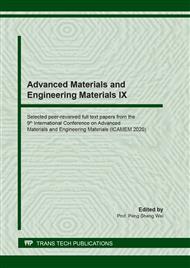[1]
Y.Q. Tan, H.N. Xu, C. Zhang, et al, Old methods and new technologies for snow removal, J. China Highway. 3 (2018) 58-63.
Google Scholar
[2]
B. Persson, Internal frost resistance and salt frost scaling of self-compacting concrete, J. Cement and Concrete Research. 33(3) (2003) 373-379.
DOI: 10.1016/s0008-8846(02)00968-7
Google Scholar
[3]
J. Marchand, M. Pigeon, D. Bager, et al, Influence of chloride solution concentration on deicer salt scaling deterioration of concrete, J. ACI Materials Journal. 96(4) (1999) 429-435.
DOI: 10.14359/642
Google Scholar
[4]
R.E. Weyers, M.G. Fitch, E.P. Larsen, et.al, Concrete bridge protection and rehabilitation: chemical and physical techniques, C. Service Life Estimates, Strategic Highway Research Program, ational Research Council, Washington, DC, (1994).
Google Scholar
[5]
A. Lindvall, Environmental actions and response-reinforced concrete structures exposed in road and marine environment, J. Nordic Concrete Research. 27(2) (2001) 63-81.
Google Scholar
[6]
Q.B. Yang, Factors influencing the pressure of ice formation in NaCl solution, J. Build. Mater. 8 (2005) 495–498.
Google Scholar
[7]
Q.B. Yang, Effects of NaCl concentration on ice-formation expansion and the solution absorption by concrete, J. Build. Mater. 10(3) (2007) 495–498.
Google Scholar
[8]
H.X. Ma, H.F. Yu, J.L. Tian, et al, The physical and mechanical properties of chloride-based deicers at 0 ~﹣30℃, J. Construction and Building Materials. 211 (2019) 721-729.
DOI: 10.1016/j.conbuildmat.2019.03.034
Google Scholar
[9]
X. Shi, N. Xie, K. Fortune, et al, Durability of steel reinforced concrete in chloride environments: an overview, J. Constr. Build. Mater. 30 (2012) 125–138.
DOI: 10.1016/j.conbuildmat.2011.12.038
Google Scholar
[10]
M. Collepardi, A. Marcialis, R. Turrizzani, The kinetics of penetration of chloride ions into the concrete, J. Cemento(Italy). 4(1970) 157-164.
Google Scholar
[11]
M. Collepardi, A. Marcialis, R. Turrizzani, Penetration of chloride ions into cement pastes and concretes, J. Journal of the American Ceramic Society. 55 (1972) 534-535.
DOI: 10.1111/j.1151-2916.1972.tb13424.x
Google Scholar
[12]
A. Lindvall, Mapping of the chloride load around two Swedish reinforced concrete bridges, M. secend ed., Department of Building Materials, Chalmers University of Technology, (2002).
Google Scholar
[13]
Y.Q. Zhang, H.F. Yu, W. Sun, et al. Investigation and study of durability of bridge under salt scaling, J. Build. Mater. 15(5) (2012) 665–669.
Google Scholar
[14]
P.L. Cong, S.F. Chen, H.X. Chen, The Influence of deicing salt on the performance of asphalt concrete, J. Highway. 6 (2011) 180-184.
Google Scholar
[15]
S. Luo, X. Yang, Performance rvaluation of high-elastic asphalt mixture containing deicing agent mafilon, J. Construction and Building Materials. 77 (2015) 59-65.
DOI: 10.1016/j.conbuildmat.2015.07.064
Google Scholar
[16]
Z.Y. He, L.P. Xiong, W.D. Yang, et al, Properties study of asphalt containing deicing agent, J. Materials Science and Engineering. 452 (2018) 1-9.
Google Scholar
[17]
F.P. Li, Z.J. Li, Experiment of road performance of asphalt mixture with automatic long-term snowmelt agent, J. Journal of Highway and Transportation Research and Development. 29(3) (2012) 7-11, 21.
DOI: 10.1061/jhtrcq.0000002
Google Scholar
[18]
Z.Z. Liu, M.L. Xing, S.F. Chen, et al, Influence of the chloride-based antifreeze filler on the properties of asphalt mixtures, J. Construction and Building Materials. 51 (2014) 133-140.
DOI: 10.1016/j.conbuildmat.2013.09.057
Google Scholar
[19]
R.C. Yang, C. Zhan, J. Yang, et al, Microscopic pore structure of asphalt mixture incorporating with MFL, J. Journal of Wuhan University of Technology-Mater. 32(5) (2017) 1232-1238.
DOI: 10.1007/s11595-017-1736-1
Google Scholar
[20]
F. Guo, Development and performance study of high-elastic salt storage asphalt mixture, D. Beijing University of Architecture. (2017).
Google Scholar
[21]
JTG D40-2011, Code for design of highway cement concrete pavement, S. China Communications Press, Peking, (2011).
Google Scholar


